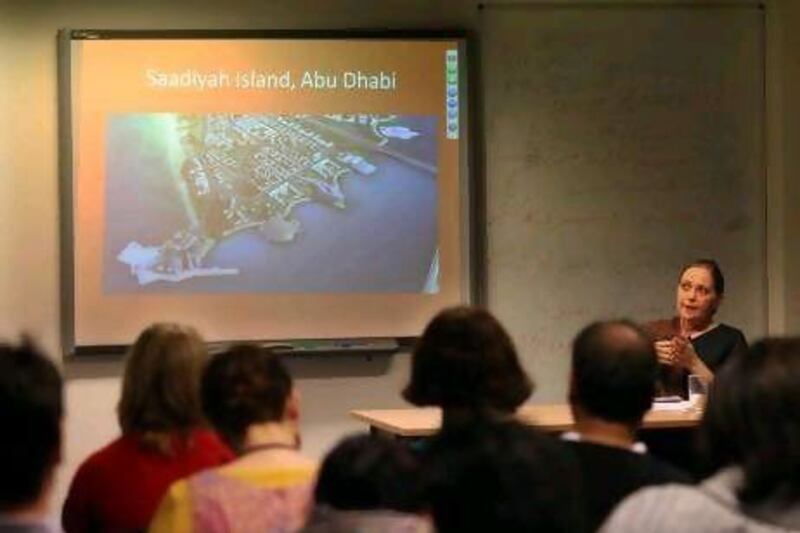In five years, the three museums of Saadiyat Island's Cultural District - Zayed National Museum, Louvre Abu Dhabi and Guggenheim Abu Dhabi - will be just about complete, and we'll have an enviable wealth of relics and artworks at our doorstep. The project has survived an uncertain global economy, but some worries still remain about how the museums will best serve local communities as well as the tourists they will inevitably attract.
Three thousand miles away at London's Aga Khan University, this was one of the topics that Dr Ulrike Al Khamis debated on a chilly evening earlier this year. Formerly the co-director of the Sharjah Museum of Islamic Civilization between 2007 and 2010, Al Khamis explained what she had learnt while helping to set up a new museum in the UAE, and how her "very personal observations" might be applied to Abu Dhabi's future museums. "I'm doing it because I want these projects to succeed," she said.
Al Khamis cautioned that, if a western partner organisation feels that it, and not the Government authorities in the UAE funding the museums, has control of a project, the situation could lead to "the themes, the objectives, the curatorial interpretation and approaches, as well as the long- and short-term objectives, being pursued according to Eurocentric museological principles and Eurocentric understanding of a reality that is not their own".
She offered as contrast the example of Sharjah's Museum of Islamic Civilization, which was staffed almost entirely by Emiratis and housed in a pre-existing souq that was already a part of the community. It incorporated the ideas that many Emiratis prefer museum-going in family groups, and like to receive information through listening and storytelling rather than solely through visuals and silent reading. "This emirate has focused in the first instance on the intellectual and educational advance of its own population before reaching out to wider audiences," she said, and talked of community outreach schemes and internships offered at the museum.
While taking the name of a world-class museum certainly suggests that the new institution will attempt to be a replica of the original, employees of Abu Dhabi's Tourism Development and Investment Company don't see it that way. Hissa Al Dhaheri, an education outreach officer, and Salama Al Shamsi, a cultural department representative, said the Abu Dhabi Government was in control of the project's vision, that the local population was at the heart of all the planning and preparations and that the museums were true to their surroundings.
"The Zayed National Museum speaks for itself, because it is such a national concept," Al Dhaheri said. "But if you look at the core curatorial concept of the Louvre Abu Dhabi, it's not about building a copy of what is in France. It's a new concept of bridging civilisations."
A classical western artwork, she said, might be presented next to Islamic or Chinese art to highlight the cross-cultural connections. As for the Guggenheim, she said that focus groups with curators, artists and academics in the capital are feeding into curatorial decisions. "This is not just a western institution trying to force what they want."
Al Shamsi is one of the first to receive a series of TDIC scholarships to complete a masters in cultural and creative industries alongside her work. It's one of 150 the company, with the Abu Dhabi Education Council, will offer over three years to train future employees in disciplines from interior design to human resources. Al Dhaheri said that in addition to this, the TDIC has encouraged area universities to offer more courses that will be relevant to employment at the museum, and that "part of our agreement with all of our national partners is that they have a responsibility to train locals".
As well as training future museum employees in the UAE, Al Shamsi said she and her team have been collecting recommendations from institutions and experts across the country to "feed into the narrative" of the Zayed National Museum. She said oral history will be a "big part of the curatorial concept" of the museum, because as a culture "we like to listen to stories, riddles and fables".
As for encouraging the local population to come along as visitors, Al Dhaheri points to the Louvre Abu Dhabi's monthly Talking Art series of lectures and workshops, which kicked off last September at the Manarat Al Saadiyat visitor centre, and the "taster" exhibitions at the same venue, such as last year's Splendours of Mesopotamia, which showcased some of the treasures that will later be at the Zayed National Museum. Events targeted at educators, children, working professionals and collectors are offered in conjunction with the exhibitions.
We will have to wait until the museums open to gauge reaction to these initiatives, but TDIC is adamant that its ears are still open to suggestions. Perhaps now is the time to head to Manarat Al Saadiyat, go to the talks, ask questions and give your opinion on what you want the Saadiyat Island Cultural District to contain.










